Disclaimer: This content is for educational purposes only, not medical advice. Always consult with a doctor before making significant changes to your diet, especially if you have pre-existing health conditions.

Natural Mounjaro recipe, that’s exactly what I searched for when I first heard people raving about Mounjaro for weight loss and appetite control. But instead of reaching for a prescription, I turned to my pantry. I’ve always believed real change starts with real food. That’s why I set out to create a natural version of this trending treatment using ingredients that support metabolism, cravings, and energy in a gentle, food-first way. In this article, I’ll share my personal story, the core ingredients I rely on, and step-by-step instructions to make your own Mounjaro-inspired tonic naturally.
Let’s start with why I chose this route.
In this Article
Key Takeaways: What You Need to Know
- The Natural Mounjaro recipe is a food-based tonic using berberine, vinegar, ginger, and cinnamon.
- It helps curb cravings, balance blood sugar, and support energy naturally.
- Easy to make at home, no prescriptions or supplements needed.
- Works best when paired with whole foods, movement, and self-care.
- Not for everyone, check with a doctor if you’re on meds or pregnant.
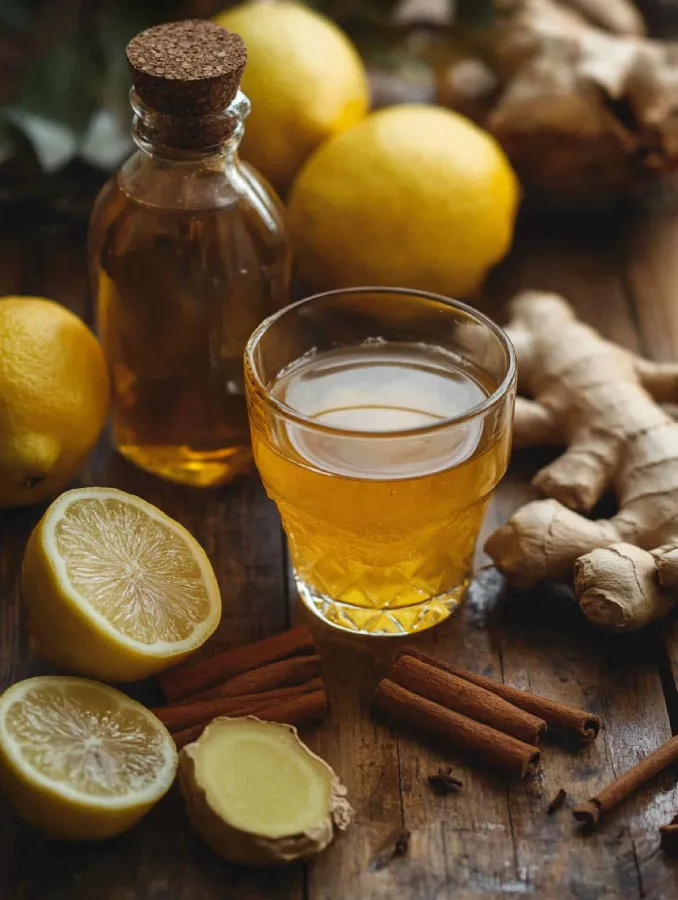
Easy Natural Mounjaro Recipe (2025)
Equipment
- Small glass
- Spoon
Ingredients
- Amount Unit Name Notes
- 1 berberine capsule 500 mg or use powdered form
- 1 tbsp apple cider vinegar with the “mother”
- 0.5 tsp ground cinnamon Ceylon preferred
- 0.5 tsp ground ginger or 1 tsp fresh grated
- 0.5 lemon juiced optional
- 1 pinch cayenne pepper optional
- 0.5 cup warm water not boiling
Instructions
- Open the berberine capsule and add the powder to a small glass.
- Add the apple cider vinegar, cinnamon, ginger, and lemon juice.
- Pour in the warm water.
- Stir thoroughly until well mixed.
- Add optional cayenne or honey if desired.
- Drink as a morning shot or before a heavy meal.
Notes
- Use Ceylon cinnamon for better digestion.
- Consult a doctor before use if taking medication.
- For best results, consume on an empty stomach in the morning.
Nutrition
Why I Created This Natural Mounjaro Recipe for Weight Loss
Recreating Mom’s Remedies with Modern Nutrition
Growing up just outside Austin, our home buzzed with big family dinners and hand-me-down recipes that worked like magic. My mom could transform pantry basics into something that healed and nourished. So when I started hearing the buzz online about the diabetes drug Mounjaro, especially how it helped curb appetite and balance blood sugar, it instantly brought her remedies to mind. She swore by cinnamon for sugar crashes and a splash of vinegar to “cut cravings.” That memory is what sparked my desire to create a natural Mounjaro recipe.
I wasn’t looking for a miracle drug. I wanted something that felt real, like the way I cook simple, nourishing, and food-first. So I reached for ingredients I already trusted: apple cider vinegar, cinnamon, ginger. I added berberine, a powerful plant-based compound with blood sugar benefits, and started testing. After a few tries, this natural Mounjaro recipe came together, and it felt right. Gentle, effective, and easy to build into my routine.
What Is the Natural Mounjaro Recipe?
A natural Mounjaro recipe is a homemade tonic made entirely from food-based ingredients that help manage blood sugar, support appetite control, and boost metabolism. Unlike pharmaceutical Mounjaro, this version skips synthetic drugs and relies on trusted natural components like berberine, cinnamon, ginger, and raw vinegar. It’s a supplement-free option that helps you feel more in control of energy swings and cravings. If you’re curious about similar drinks, don’t miss our natural Mounjaro tea recipe.
This isn’t a trendy powder or supplement, it’s a simple, blended formula you can make at home with ingredients you probably already have. Each one has been studied for its metabolic benefits, making this natural Mounjaro recipe both science-backed and kitchen-friendly. Think of it as a daily wellness shot to help you stay steady between meals.
The recipe includes:
- Berberine – a plant alkaloid often compared to metformin
- Apple cider vinegar – known to reduce glucose spikes and cravings
- Cinnamon – shown to support insulin sensitivity
- Ginger – promotes digestion and thermogenesis
Though this tonic doesn’t act like a drug, its purpose is similar to Mounjaro: to help you stay in tune with your hunger cues and energy. Personally, I’ve found it incredibly supportive, especially when combined with whole foods, light movement, and other natural wellness tools. If you’re exploring gentle, metabolism-friendly habits, this natural Mounjaro recipe is a smart and simple place to start.
Want to explore more functional drinks that support your routine? Try our apple cider vinegar and cranberry juice blend, another go-to in my kitchen..
How the Natural Mounjaro Recipe Works to Curb Cravings
How Mounjaro Works?
To really understand the value of a natural Mounjaro recipe, it helps to know what the pharmaceutical version actually does. Mounjaro is the brand name for tirzepatide, a medication originally developed for type 2 diabetes. It works by mimicking two hormones, GLP-1 and GIP, that help regulate blood sugar, slow digestion, and reduce appetite. This dual-action design is why it’s been making headlines for its impact on weight loss.
But for those of us who prefer a more food-based approach or aren’t eligible for prescription use, the question becomes: Can you support similar pathways with natural ingredients?
While herbs and foods don’t act like drugs, they can influence the body’s response to insulin, glucose, and hunger in meaningful ways. That’s the idea behind this natural version. It’s not about replicating pharmaceutical potency, it’s about encouraging balance and gentle regulation through what you eat and drink every day.
For more on how to support your body’s natural rhythms with real food, you might also like the post on Quick Prep Drinks for Busy Mornings, which includes options that support blood sugar and digestion without the use of supplements.
Key Natural Ingredients for natural mounjaro recipe:
Here’s a breakdown of the ingredients used in this natural Mounjaro recipe and what the science says about their roles in appetite, metabolism, and blood sugar control:
| Ingredient | Known Benefit |
|---|---|
| Berberine | a plant alkaloid often compared to metformin and clinically studied for its blood sugar support |
| Apple Cider Vinegar | Shown to improve glycemic response and curb cravings |
| Cinnamon | May support insulin sensitivity and reduce blood sugar spikes |
| Ginger | Supports digestion and thermogenesis (natural fat-burning) |
Many of these ingredients have a long history in traditional medicine. Now, modern research is starting to confirm what folk remedies have suggested for centuries.
If you’re curious about other natural tools that support insulin health and appetite balance, check out our Natural Appetite Control Tricks article next. You’ll find more ideas that pair well with this daily tonic.
Is Mounjaro a Natural Drink?
No, the prescription Mounjaro is not a drink, it’s an injectable medication used for type 2 diabetes. However, this homemade recipe is a drink that mimics some of its effects using natural ingredients. This version is blended at home with pantry staples and consumed as a morning shot or sipper to gently support energy and appetite. If you’re into similar metabolism-boosting drinks, don’t miss our apple cider vinegar and cranberry recipe.
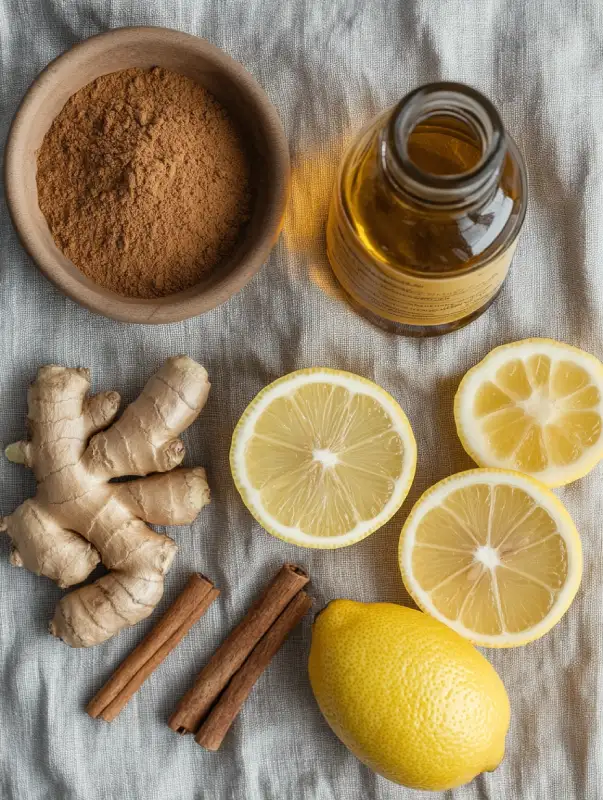
How to Make the Natural Mounjaro Recipe at Home
Ingredients You’ll Need
Making a natural Mounjaro recipe doesn’t require fancy equipment or rare ingredients. Everything you need is likely already in your pantry or easy to find at your local health store. This recipe creates a single serving, but you can easily scale it for a small batch.
Here’s what you’ll need:
- 1 capsule berberine (500 mg) – or equivalent powder
- 1 tablespoon raw apple cider vinegar – look for one with the “mother”
- ½ teaspoon ground cinnamon – Ceylon if available
- ½ teaspoon ground ginger – or 1 teaspoon fresh grated
- Juice of ½ lemon – optional, for flavor and detox support
- Pinch of cayenne pepper – optional, for thermogenic effect
- ½ cup warm water – not boiling
You can also add a teaspoon of raw honey if the taste is too intense, though this is optional depending on your dietary goals.
Looking for more drinks that fit into a natural blood sugar routine? Browse our Blood Sugar-Friendly Recipes section to discover blends and meals that pair beautifully with this one.

3-Ingredient Brazilian Mounjaro
Equipment
- 1 Small glass jar With lid, for shaking
- 1 Teaspoon or whisk For mixing ingredients
Ingredients
- 1 tablespoon apple cider vinegar Raw with the mother
- ½ teaspoon ground cinnamon Preferably Ceylon
- ½ cup warm water Not boiling—just warm for blending ease
Instructions
- Pour in warm water.
- Mix well or shake in a jar until fully blended.
- Drink in the morning on an empty stomach or before meals.
Notes
Nutrition
Step-by-Step Instructions for the Herbal Shot
This natural Mounjaro recipe can be enjoyed as a morning shot or a slow sip depending on your routine. Here’s how to prepare it:
- Open the berberine capsule (or measure powder) and place in a small glass.
- Add the apple cider vinegar, cinnamon, ginger, and lemon juice.
- Pour in the warm water (not too hot, or it can affect potency).
- Stir well until all powders are fully dissolved.
- Optionally, add honey or cayenne to adjust taste and heat.
- Drink it first thing in the morning or before a carb-heavy meal.
Pro tip: Shake the ingredients in a small mason jar for smoother mixing. If you prefer sipping slowly, add a few ice cubes and a slice of lemon.
Some readers have asked how long to take this blend. I usually recommend using it daily for 3–4 weeks, then taking a short break. And always pay attention to how your body feels, this should support you, not stress your system.
If you’re short on time in the mornings, try our Quick Prep Drinks for Busy Mornings, which includes other metabolism-supporting blends that prep in under 2 minutes.

Does the Natural Mounjaro Recipe Really Work for Weight Loss?
What Results Can You Expect?
When it comes to a natural Mounjaro recipe, realistic expectations are key. This isn’t a pharmaceutical, it won’t suppress your appetite overnight or cause rapid weight loss. But what it can do, when taken consistently and paired with a nutrient-dense diet, is help reduce sugar cravings, improve energy stability, and support better portion control.
In my experience, and from readers who’ve tried this blend, the most common early shifts include:
- Feeling fuller longer after meals
- Fewer snack cravings at night
- More stable energy between meals
- Gentler digestion
After about 2–3 weeks, I started noticing that I wasn’t reaching for sweets in the afternoon like I used to. My meals felt more satisfying, and I didn’t need to “willpower” my way through the day. That, to me, is a win.
One of my readers recently shared how adding this to her routine alongside better sleep and a daily walk helped her lose 6 pounds in a month, without counting calories. That’s the kind of gentle, habit-supported change I’m all about.
If you’re looking for more holistic routines like this, check out our post on Healthy Lifestyle on a Budget, it’s full of sustainable ideas that make wellness feel doable, not demanding.
Who Should Avoid or Consult a Doctor
Even though this recipe is made with food-based ingredients, it’s not for everyone. Always talk to your doctor or a licensed health provider before adding any supplement or new blend to your routine, especially if you:
- Are pregnant or breastfeeding
- Take blood sugar medications (like metformin or insulin)
- Have a sensitive stomach or reflux
- Have any chronic health conditions
Berberine, in particular, can interact with medications and should be taken with medical guidance. If you feel dizzy, overly tired, or notice digestive upset, it’s best to pause and reassess.
As always, natural doesn’t automatically mean “safe for all.” Your body is unique, honor that.
For more safe and practical swaps, our Natural Weight Management Tips category is a great next stop. It’s filled with food-first, stress-free approaches that meet you where you are.
Natural Mounjaro vs. Prescription Mounjaro
How Does the Natural Mounjaro Recipe Compare to Prescription Mounjaro?
The natural Mounjaro recipe is a food-based tonic designed to gently support blood sugar balance and appetite control, offering a kitchen-made alternative to the prescription Mounjaro injection. Pharmaceutical Mounjaro (tirzepatide) is an injectable medication with faster and stronger effects, but it requires a prescription.
Here’s a quick comparison:
| Feature | Natural Mounjaro Recipe | Prescription Mounjaro |
|---|---|---|
| Main Ingredients | Berberine, vinegar, cinnamon, ginger | Tirzepatide |
| Form | Drink/Tonic | Injection |
| Effect Speed | Gradual (weeks) | Faster (days/weeks) |
| Accessibility | Kitchen ingredients | Prescription only |
| Side Effects | Mild digestive changes | Possible nausea, GI issues |
If you prefer gradual, sustainable changes without medical intervention, the natural version is a good place to start.
Safety & Best Practices for the Natural Mounjaro Recipe
How to Safely Use the Natural Mounjaro Recipe
Even though the natural Mounjaro recipe uses familiar kitchen ingredients, it’s not right for everyone, and following a few safety guidelines can help you get the best results. Keep these guidelines in mind:
- Start with half the recipe if you’re new to berberine or apple cider vinegar.
- Drink it in the morning for best results and to avoid interfering with evening digestion.
- Skip it if you are pregnant, breastfeeding, or on blood sugar–lowering medications without consulting your doctor.
- Always monitor how your body responds, this is meant to support you, not stress your system.
According to the National Center for Complementary and Integrative Health (NIH.gov), cinnamon has been studied for its potential role in supporting healthy blood sugar levels, which makes it a smart addition to this blend.
Natural Mounjaro Recipe FAQs
What is a natural alternative to Mounjaro?
A natural alternative to Mounjaro is a drink made with berberine, apple cider vinegar, cinnamon, and ginger. This natural Mounjaro recipe supports blood sugar balance, curbs cravings, and may gently encourage weight loss when taken daily.
Does natural Mounjaro really work?
Yes, many people find the natural Mounjaro recipe helps control cravings and balance energy levels. While it’s not as fast-acting as pharmaceutical Mounjaro, it can be effective when paired with healthy eating and regular movement.
What are the ingredients in Mounjaro?
The prescription version contains tirzepatide, which mimics two hormones (GLP-1 and GIP) to regulate blood sugar and reduce appetite. The natural Mounjaro recipe uses berberine, vinegar, cinnamon, and ginger to mimic some of those effects naturally.
What is Brazilian Manjaro?
Brazilian Manjaro is an informal term for herbal teas or metabolism blends popular in Brazil. It’s not an official product but often includes ingredients similar to the natural Mounjaro recipe.
Bonus: What Makes This Recipe Stand Out from Other Natural Versions?
What makes this natural Mounjaro recipe different is the inclusion of berberine, a powerful botanical compound studied for its insulin-mimicking effects. While many blends stop at vinegar and lemon, this one is designed for those looking for science-backed plant power. Want to compare with other variations? Explore the official Natural Mounjaro Ingredients breakdown and see how this one stacks up.
Conclusion
Creating a natural Mounjaro recipe has helped me find a grounded, nourishing way to support my body without relying on trends or prescriptions. It’s not about perfection, it’s about progress through real food, small rituals, and listening to what your body needs. If you’re curious, give this recipe a try and see how you feel. Then explore more of my natural recipes and wellness blends here on EatWellWell. This is about building joyful habits, one sip at a time.
Tried this Natural Mounjaro Recipe? Share your experience on Pinterest or LinkedIn. Your story could inspire someone else to take a natural step toward better energy and craving control.
For more recipes, visit our Facebook and Pinterest

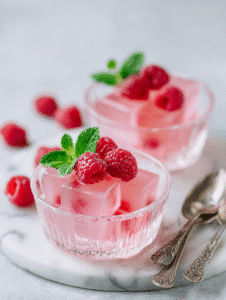
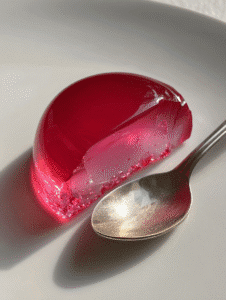
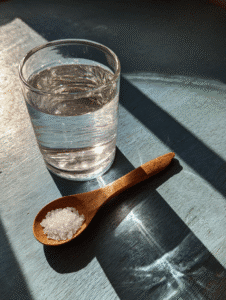
7 thoughts on “Natural Mounjaro Recipe for Weight Loss & Craving Control (2025)”